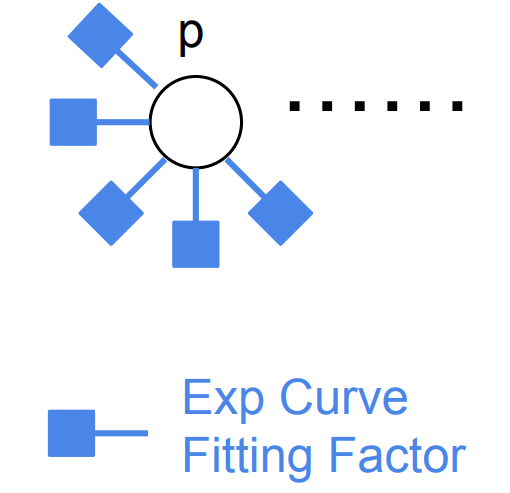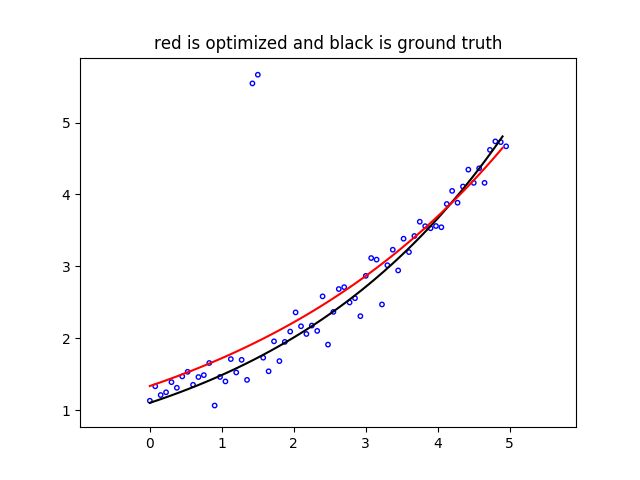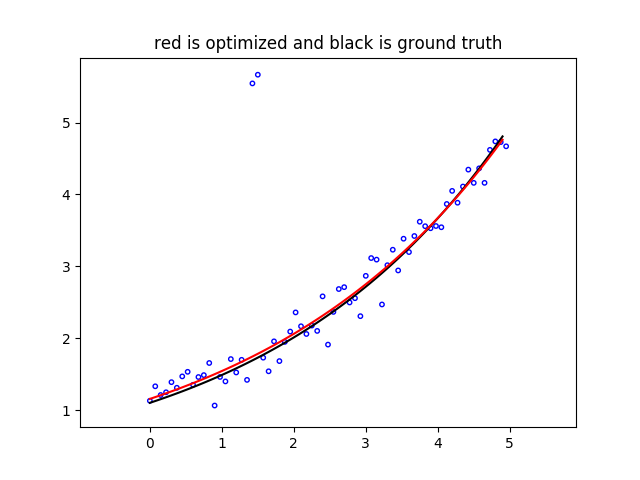Robust Curve Fitting Example¶
Python and C++ code of this example can be found at robust_curve_fitting.py and robust_curve_fitting.cpp respectively.
Here we give a simple example of how to solve a general least square problem in the framework of factor graph, even if the problem does not have a clear graph structure.
The problem we solve here is curve fitting, we are using the same exmaple shown on Ceres tutorial. The input is a set of 2D points \((x_i, y_i)\), and we are fitting a curve defined by exponential
The curve fitting problem can be solved by solving non-linear least squares
Where \(m\) and \(c\) are the curve parameters to optimize, and \(\rho\) is a loss function. We define a parameter variable vector \(p \in \mathbb{R}^2\) to optimize
For curve fitting problem with \(N\) points, the factor graph of the problem has only a single variable \(p\), and with \(N\) unary factors connected to \(p\), which has a star structure, shown in figure below.

The error vector of the factor is defined by
and the Jacobian matrix is
Python code example¶
We first define the exponential curve fitting factor in Python
# exp curve fitting factor
class ExpCurveFittingFactor(Factor):
# ctor
def __init__(self, key, point, loss):
Factor.__init__(self, 1, [key], loss)
self.p_ = point
# make a deep copy
def copy(self):
return ExpCurveFittingFactor(self.keys()[0], self.p_, self.lossFunction())
# error = y - exp(m * x + c);
def error(self, variables):
params = variables.at(self.keys()[0])
return np.array([self.p_[1] - math.exp(params[0] * self.p_[0] + params[1])])
# jacobians
def jacobians(self, variables):
params = variables.at(self.keys()[0])
J_e_mc = np.array([[-self.p_[0] * math.exp(params[0] * self.p_[0] + params[1]),
-math.exp(params[0] * self.p_[0] + params[1])]])
return [J_e_mc]
The graph is built by following code. In the example code we use key \(p_0\) for the curve variable.
# build graph
graph = FactorGraph()
for d in data:
graph.add(ExpCurveFittingFactor(key('p', 0), d, loss))
In the example we are using a 62 points datasets, in which 60 points are random generated points around ground truth curve, and 2 are outliers.
First we set loss function \(\rho\) to identity, in the code we simply set loss function of factor to None
# use None is no loss function is used
loss = None
solve the problem and plot the fitted curve (in red) with data points (in blue) and ground truth curve (in black).

We can see that the result curve is biased towards to two outliers, since the error is driven by two outliers which have large errors. If we use Cauchy robust loss function as \(\rho\),
# use robust (Cauchy) loss function
loss = CauchyLoss.Cauchy(1.0)
we get much better fitted curve.
